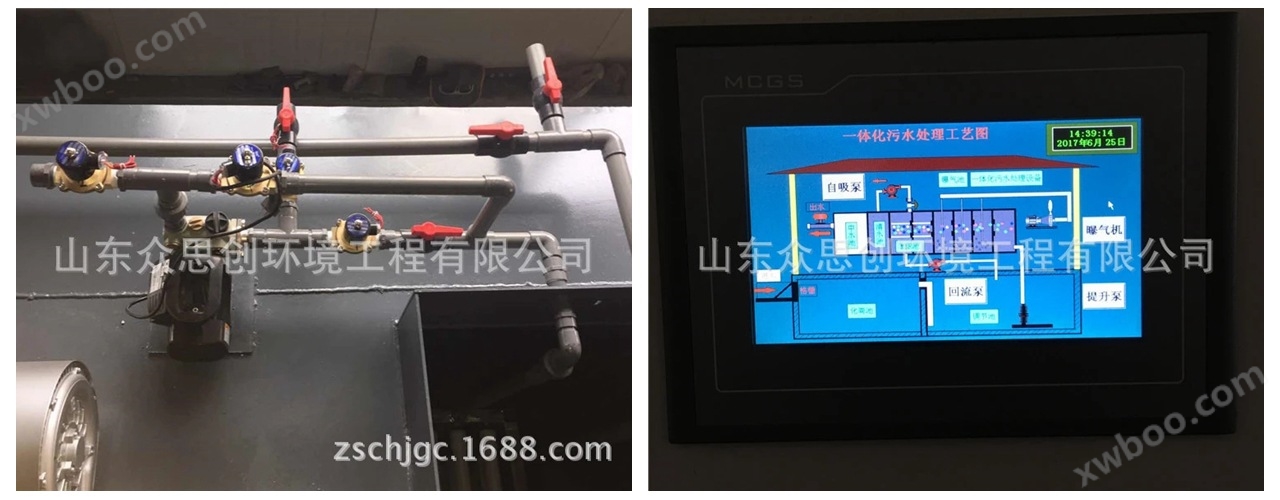
membrane bioreactorbrief introduction
Membrane Bio Reactor (MBR) is a novel wastewater treatment system that combines membrane separation technology with biological treatment technology. Replacing traditional biological treatment technology with membrane modules in the terminal secondary sedimentation tank, maintaining a high concentration of activated sludge in the bioreactor, increasing the organic load of biological treatment, thereby reducing the footprint of sewage treatment facilities, and reducing the amount of remaining sludge by maintaining a low sludge load. Mainly utilizing membrane separation equipment immersed in aerobic biological tanks to intercept activated sludge and large molecular organic matter in the tank. The concentration of activated sludge (MLSS) in the membrane bioreactor system can be increased to 8000-10000 mg/L, or even higher; The sludge age (SRT) can be extended to over 30 days.
Advantages of membrane bioreactor
1. Efficiently performing solid-liquid separation, its separation effect is much better than traditional sedimentation tanks, the effluent quality is good, the suspended solids and turbidity in the effluent are close to zero, and it can be directly reused, achieving sewage resource utilization.
2. The efficient retention effect of the membrane enables microorganisms to be completely retained in the bioreactor, achieving complete separation of hydraulic retention time (HRT) and sludge age (SRT) in the reactor, and flexible and stable operation control.
3. Due to the MBR combining the aeration tank and secondary sedimentation tank of traditional sewage treatment into one, and replacing all the process facilities of tertiary treatment, it can significantly reduce the footprint and save civil engineering investment.
4. Beneficial for the interception and reproduction of nitrifying bacteria, the system has high nitrification efficiency. By changing the operating mode, there can also be ammonia and phosphorus removal functions.
5. Due to the fact that the age of the mud can be very long, it greatly improves the degradation efficiency of difficult to degrade organic matter.
6. The reactor operates under high volume load, low sludge load, and long sludge age, resulting in extremely low residual sludge production. Due to the infinite sludge age, theoretically zero sludge discharge can be achieved.
7. The system is controlled by PLC, making operation and management convenient.

Characteristics of integrated sewage treatment equipment
1. Buried below the surface, the surface above the equipment can be used for greening or other purposes, without the need for building houses, heating, or insulation.
2. The secondary biological contact oxidation treatment process adopts push flow biological contact oxidation, which has a better treatment effect than fully mixed or two-stage series fully mixed biological contact oxidation tanks. And it has a smaller volume than activated sludge tanks, strong adaptability to water quality, good shock load resistance, stable effluent quality, and will not cause sludge expansion. A new type of elastic three-dimensional packing material is used in the pool, with a large specific surface area and easy biofilm formation and detachment by microorganisms. Under the same organic load conditions, it has a high removal rate of organic matter and can improve the solubility of oxygen in the air in water.
3. The biochemical tank adopts the biological contact oxidation method, which has a relatively low volume load of the filling material, and the microorganisms are in their own oxidation stage, resulting in low sludge production. It only takes more than three months (90 days) to discharge the sludge (using fecal trucks to suction or dehydrate into sludge cakes for external transportation).
4. The deodorization method of this buried domestic sewage treatment equipment not only uses conventional high-altitude exhaust, but also includes soil deodorization measures.
5. The entire equipment processing system is equipped with a fully automatic electrical control system and equipment fault alarm system, which operates safely and reliably. Generally, there is no need for dedicated personnel to manage it, and only timely maintenance and upkeep of the equipment is required.
MBR Integrated Wastewater Treatment Equipment Process Flow Diagram

Brief description of sewage treatment process

Domestic sewage is collected in the living area and enters the septic tank for initial sedimentation. It then enters the regulating tank through a grid well for uniform mixing. As the sewage may contain some large suspended solids, a grid is installed to remove them before entering the regulating tank, which can effectively reduce the subsequent biological treatment load and prevent large suspended solids from blocking the subsequent treatment equipment.
The wastewater treated by the grid flows automatically into the regulating tank. Anaerobic bacteria are introduced into the regulating tank to acidify and degrade the organic matter in the wastewater. After sedimentation, homogenization, acidification, and degradation in the regulating tank. The pump is lifted into the integrated treatment system of activated sludge method. The biochemical method mainly adopts a series process of acidification hydrolysis aerobic oxidation. The purpose of acidification hydrolysis is to hydrolyze and acidify certain high molecular weight substances and soluble substances with poor biodegradability in the wastewater, degrade them into small molecular weight substances and soluble substances, and create conditions for subsequent aerobic biochemical treatment. The aerobic oxidation process adopts the biological contact oxidation method, which is one of the commonly used aerobic biological treatment methods for large and medium-sized wastewater due to its ease of management, low sludge production, resistance to sludge expansion, and low operating costs. At the same time, the sludge generated by aerobic biochemical treatment is partially refluxed to the facultative biochemical section through the sedimentation tank to increase the microbial content.
After biochemical treatment, the water flows into the sedimentation tank and undergoes solid-liquid separation. After entering the clean water tank and being disinfected, it meets the discharge or reuse standards. Part of the separated sludge flows back into the biochemical system, while the remaining sludge is discharged into the sludge concentration tank.
![7G[P{E(660]EA4@1(O@G24F_副本](http://img76.mtnets.com/5/20201210/637432189171909866487.jpg)





![7G[P{E(660]EA4@1(O@G24F_副本_副本](http://img78.mtnets.com/5/20201210/637432189185564038935.jpg)



